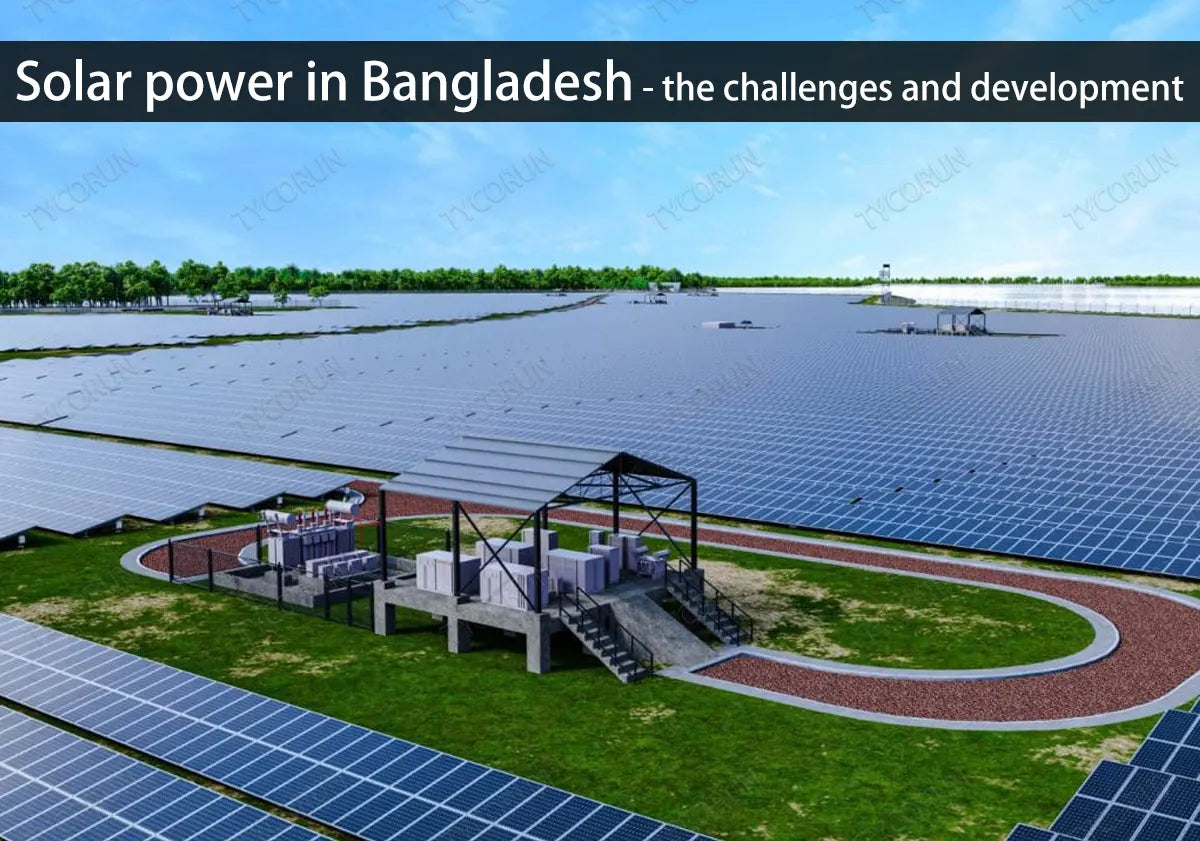
In recent years, the stable domestic political situation has laid a solid foundation for Bangladesh's economic development. However, rapid economic development has brought huge pressure on the ecological environment.
Bangladesh has actively explored ways to reduce climate impacts and introduced various policies in the field of renewable energy development, which reflects Bangladesh's efforts to mitigate the adverse effects of climate change. This article will introduce to you the policies in developing solar power in Bangladesh, and the difficulties and challenges it faces.
Main content:
1. Current status of power industry in Bangladesh
Bangladesh is located in South Asia and is one of the fastest-growing economies in the world in recent years. While facing economic development challenges, it is also facing challenges brought about by climate change. The power industry is a key part of development in Bangladesh. Ensuring power stability plays a major strategic role in eliminating local poverty, ensuring national security, and promoting economic growth. Bangladesh's energy resource endowment is poor. The traditional fossil energy is rich in gas but short of coal and oil, which makes it an energy importer and is highly dependent on foreign technology and funds.
Data shows that in the 2020-2021 fiscal year, Bangladesh's national power generation capacity was approximately 80,423Gwh (including 8,103Gwh imported power), and per capita power generation and electricity consumption were 475kWh and 422kWh respectively.
However, limited by its resource endowment and the historical layout of the energy industry, Bangladesh's current power structure is unreasonable, over-reliant on traditional fossil energy sources such as kerosene, oil and gas (the total proportion is as high as nearly 90%), while green and low-carbon renewable energy power generation charges only about 1% (see figure below).
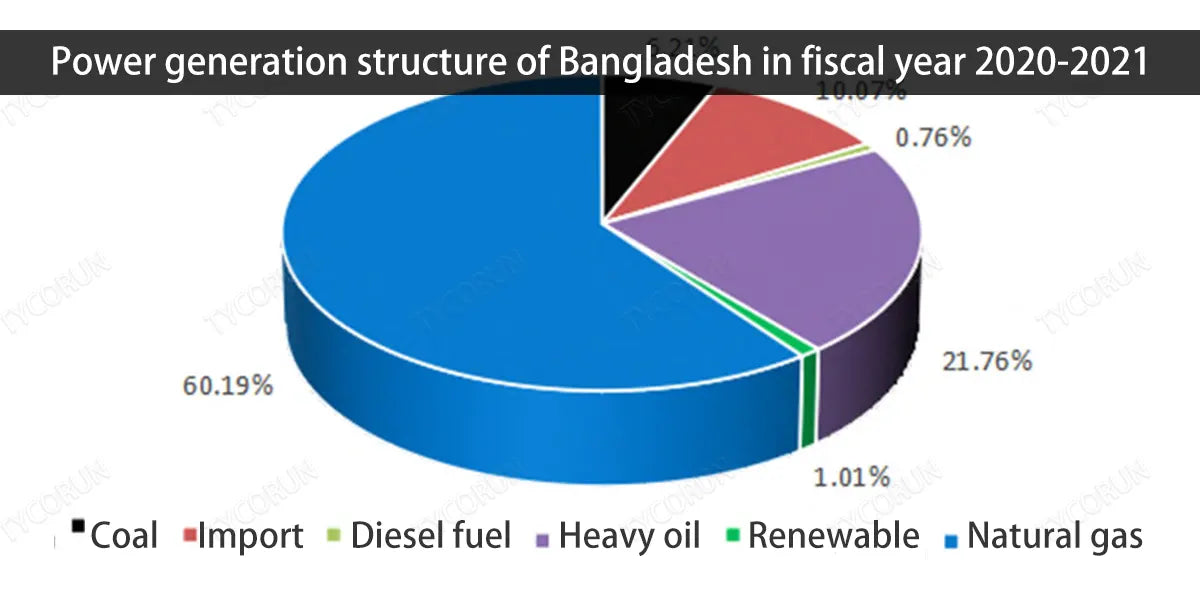
2. Renewable energy generation in Bangladesh
For more than ten years, the Bangladesh government has focused on expanding the development and utilization of renewable energy. The "Renewable Energy Policy" formulated in 2008 stipulated that 10% of the total electricity demand should come from various renewable energy sources by 2021.
In the following more than ten years, this requirement has been repeatedly emphasized in many important policy documents. Unfortunately, even if Bangladesh modifies this fulfillment time to 2025 in the latest Eighth Five-Year Plan (2021-2025), it will be difficult to achieve the goal of a 10% share of renewable energy power generation. As of March 2022, the specific composition of Bangladesh's renewable energy power generation is as shown in the table below.
|
Renewable energy generation structure of Bangladesh |
||||
|
Type |
Off-grid power generation (MW) |
On-grid power generation (MW) |
Subtotal (MW) |
Proportion (%) |
|
Solar energy |
347.52 |
198.28 |
545.8 |
69.99 |
|
Water energy |
0 |
230 |
230 |
29.5 |
|
Wind energy |
2 |
0.9 |
2.9 |
0.37 |
|
Biomass energy |
1.09 |
0 |
1.09 |
0.14 |
|
Total |
350.61 |
429.18 |
779.79 |
100 |
Data source: Bangladesh Government Renewable Energy Database website
Although the proportion of renewable energy power generation is low, Bangladesh has a long history and extensive application in this field. As early as 1957 during the East Pakistan period, Bangladesh began to construct water power on-grid projects on the Karnaphuli River in the Chittagong area. And it also introduced foreign-funded enterprises many times to carry out wind data collection and scientific research.
With the intensity of scientific research in recent years, wind energy is expected to become the third largest renewable energy source for on-grid power generation in Bangladesh. In addition to on-grid power generation, Bangladesh attaches great importance to remote off grid solar power system in the rural areas. Off-grid power generation resources mainly include biomass energy used for cooking, drying grains, etc., and the more widely used solar home system (SHS). The latter is the largest renewable energy project in Bangladesh, helping the country achieve the goal of 100% electricity supply.
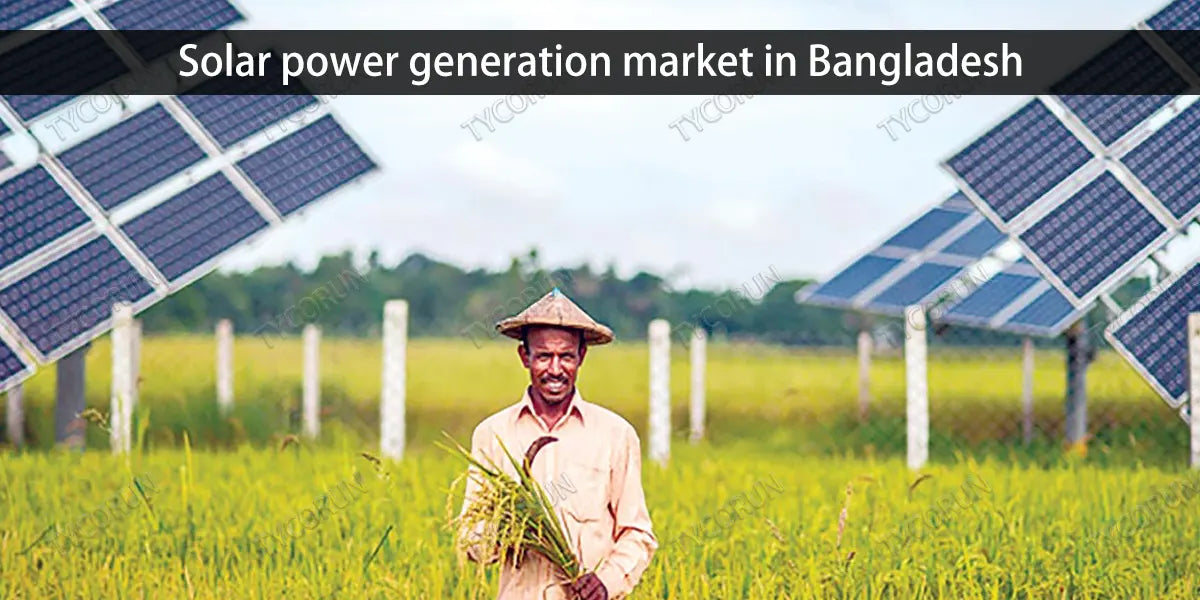
3. Solar power generation market in Bangladesh
Overview of solar power in Bangladesh
Considering the limitations of hydropower, wind power, and biomass power generation, Bangladesh regards solar power in Bangladesh, especially photovoltaic power generation, as the biggest priority in future renewable energy development. Bangladesh is located in South Asia, with abundant sunshine throughout the year. The average daily solar radiation can reach 4.0~6.5 kilowatt hours/square meter, and can produce 1018×1018 joules of energy. It is such sufficient light that makes Bangladesh particularly capable of developing solar power in Bangladesh, which is an objective condition for large-scale photovoltaic power plants.
At present, Bangladesh has made certain progress in the fields of home solar power system, solar roof projects, solar mini-grids, solar irrigation, etc., but the development of large-scale photovoltaic power plants is still in its infancy. The drive to transform the power generation structure, objective conditions for sufficient sunlight, and strong policy support are conducive to overall planning and unified deployment, shaping the medium- and long-term industrial layout, and creating a favorable foundation for the comprehensive and stable development of the industry of solar power in Bangladesh.
Policies for solar power in Bangladesh
In recent years, Bangladesh has successively introduced policies and regulations that provide strong support for the development and utilization of solar power in Bangladesh, such as the Renewable Energy Policy, the Sustainable and Renewable Energy Development Authority Act, the Implementation Guidelines for Solar Power Development Projects, and the Bangladesh Delta Action 2100 Plan, National Solar Energy Action Plan (2021-2041) and so on.
Since Bangladesh Prime Minister Hasina served as the chairperson of the Forum of Vulnerable Countries Vulnerable to Climate Impacts in June 2020, Bangladesh has re-examined various domestic energy policies and paid full attention to the development and utilization of renewable energy, especially solar power in Bangladesh.
And the latest Mujib Climate Prosperity Plan (MCPP) has even set ambitious goals: 12 solar projects will be built by 2030, adding 500MW of solar power generation to the country; and the proportion of renewable energy power generation will increase to 40% by 2041. The promulgation of MCPP has built a bridge between existing policies, supplemented and accelerated them, and pointed out a clear direction for the development of renewable energy. Taking this opportunity, the market development of solar power in Bangladesh has officially entered the fast lane.
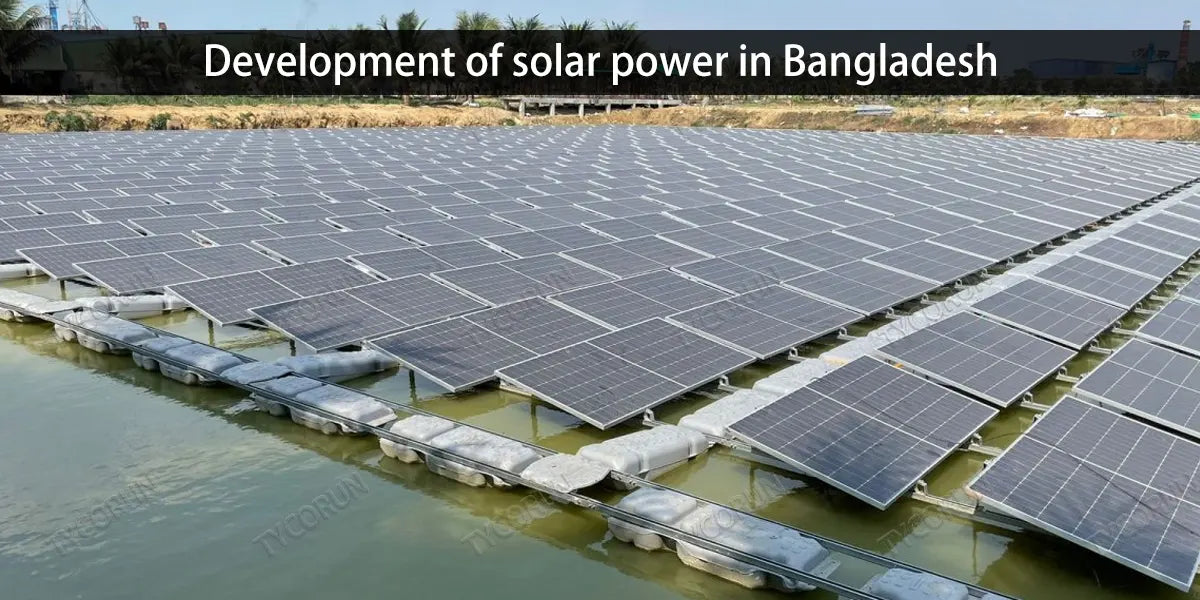
4. Development of solar power in Bangladesh
Based on the Bangladeshi government’s years of operation and the active participation of foreign-funded enterprises in development, supplemented by the strong promotion of MCPP, the industry of solar power in Bangladesh has rapidly entered a stage of vigorous development, with new projects constantly being signed or put into commercial operation.
Since the release of MCPP, many photovoltaic projects have successfully passed government approval or completed contract signing, such as Narayanganj 100MW project, Feni 100MW project, Jamalpur 100MW project, Sundarganj 280MW project, etc.
During the same period, a number of solar photovoltaic power plants were put into commercial operation, such as the Mymensingh 73MW project, the Sirajganj 7.8MW project, the Manikganj 35MW project, and the Bagerha 130MW project.
5. Challenges facing the industry of solar power in Bangladesh
Despite the promising prospects, the early progress of the market development of solar power in Bangladesh was relatively slow. The main reasons are as follows:
① Difficulty in acquiring land
Bangladesh has a large population, a small land area, and private land ownership. However, the land area owned by a single landowner is limited, making land acquisition very difficult. In addition, the selection of sites such as river banks suitable for photovoltaic project development also faces problems such as filling and reinforcement, which increases the uncertainty of project costs.
In recent years, photovoltaic bidding projects issued by the Bangladesh Power Development Board (BPDB) still require bidders to be responsible for solving land issues, which greatly increases the difficulty of bidding and discourages bidders. The current situation mentioned above shows that land issues have become one of the most important factors restricting the development of large-scale on-grid photovoltaic projects in Bangladesh.
However, it is worth mentioning that the demand for land per unit of power generation will continue to decrease with technological changes; the combination of agricultural and photovoltaic complementation, fishery and photovoltaic complementation and other composite land use methods will gradually fade away. Popularization will greatly improve land utilization and so on, which will help gradually alleviate land problems in the future.
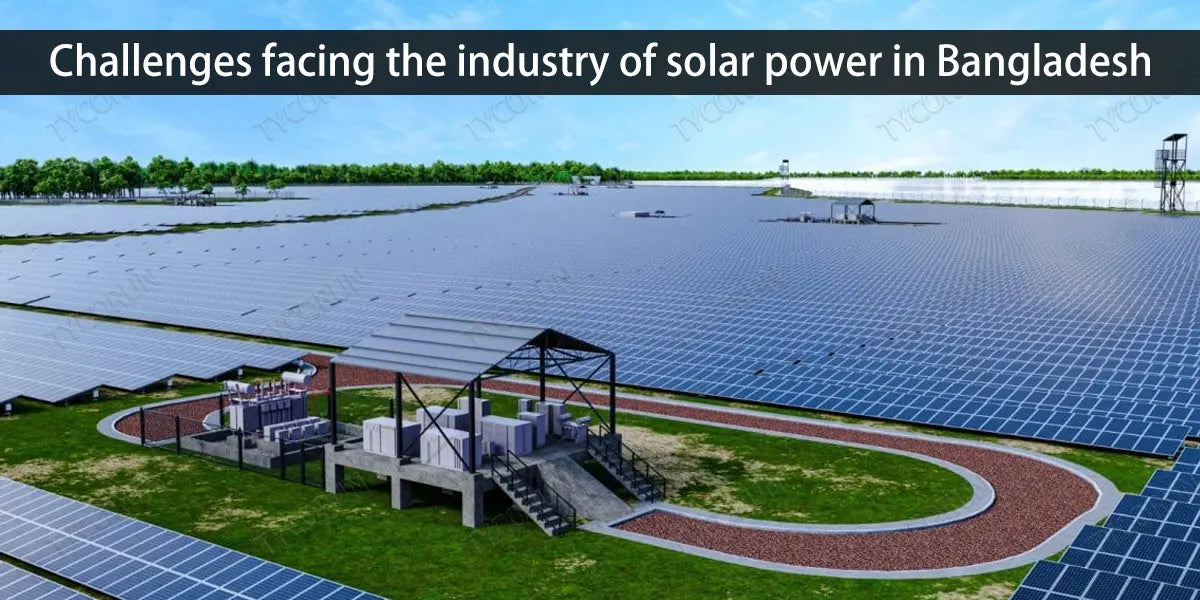
② Inadequate policy system
Although Bangladesh has attached great importance to the development of renewable energy, especially solar power in Bangladesh in recent years, some policies often remain on paper, and there are certain contradictions between the policies of various departments, resulting in unfavorable coordination, and low government efficiency will lead to obstruction of implementation. Therefore, strong ongoing policy support and effective supervision and guidance from competent authorities are particularly important.
③ Lagging behind in industrial support
The photovoltaic industry is a high-tech industry that integrates optics, semiconductors, chemicals, machinery, etc., and the industrial chain has a high technical content. However, Bangladesh is lagging behind in industrial development and does not have a mature domestic photovoltaic industry cluster.
There is no domestic industrial support in the fields of upstream crystalline silicon and other raw materials, midstream LFP battery or other components such as 2000w inverter or 3000w inverter, downstream power generation applications, etc., which leads to the fact that the equipment and parts required for the construction, operation and maintenance of PV power plants in Bangladesh are entirely imported from abroad, and the professional and technical personnel required for the projects are also entirely from abroad.
The lack of domestic equipment manufacturing industry, backward logistics and transportation system, shortage of local technical personnel, etc., have brought huge challenges to the development of solar power in Bangladesh. Therefore, before reshaping the industrial logic, building an internal cycle, and ultimately realizing independent research and development of photovoltaic projects, Bangladesh has no choice but to continue to introduce external support, make up for its own shortcomings, and promote industrial development.
Related posts: solar energy in Indonesia, solar energy in Malaysia, global top 10 best solar inverter brands